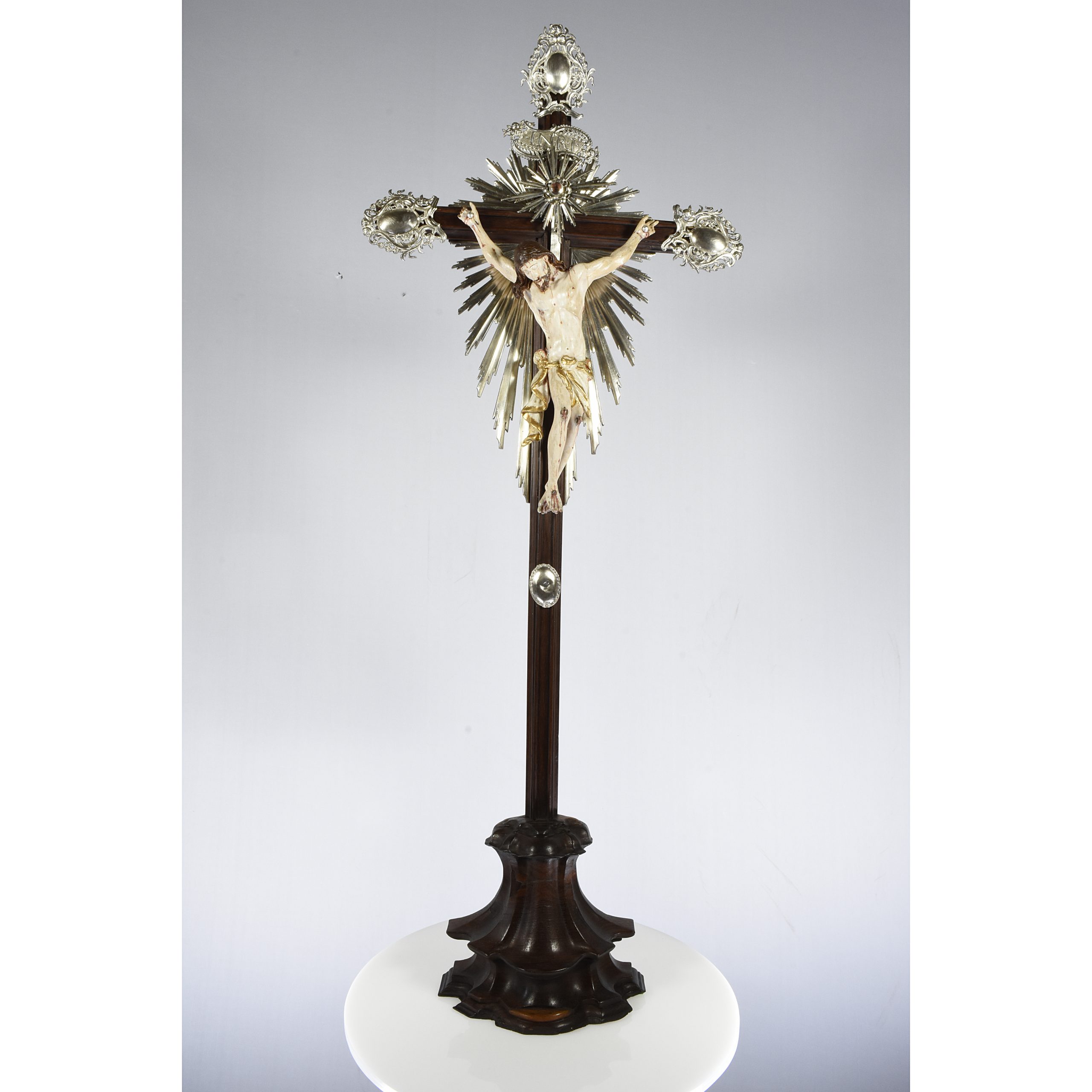Oratório Envidrado de Salão
Autor: Desconhecido
Material/Técnica: Madeira/Cera/Tecido/ Vidro/Entalhe/Enceramento
Século: XX
Procedência: Catedral Senhor do Bom Jesus de Cuiabá
Dimensão: 120 x 70 x 41 cm
Dados Históricos: Peça de madeira com entalhes simples sem torneamento, revestida internamente de veludo vermelho. Os oratórios são objetos que expressam a fé e a religiosidade da humanidade desde os tempos mais remotos e refletem a passagem do universo grandioso das igrejas para o espaço íntimo do cotidiano doméstico. Mesmo sendo minúsculas capelas ou modestas caixas para abrigar o santo de devoção, representam o altar-capela das casas-grandes de engenho, a partir do séc. XVII, cujas características estéticas seguiram os modelos da época, especialmente barroco e rococó. A ornamentação de seus interiores recebeu, no fundo e nas portas, em sua maioria, pinturas coloridas com flores ou figuras de santos da invocação preferida. Outros são de coloração mais simples, porém enobrecidos com detalhes em douramento. Os menos eruditos e mais populares não apresentam muitos elementos decorativos, como o oratório acima, de madeira entalhada, referências mais sóbrias e maior simplicidade.
Hall Glazed Oratory
Author: Unknown
Material / Technique: Wood / Wax / Fabric / Glass / Carving / Waxing
20th Century
Origin: Good Lord Jesus of Cuiabá Cathedral
Dimension: 120 x 70 x 41 cm
Historical Date: Piece of wood with simple carvings without turning, covered internally with red velvet. Oratories are objects that express the faith and religiosity of humanity since the most remote times and reflect the passage of the grandiose universe of the churches to the intimate space of domestic daily life. Even though they are tiny chapels or modest boxes to house the saint of devotion, they represent the altar-chapel of the big mill houses, from the 19th century. XVII, whose aesthetic characteristics followed the models of the time, especially Baroque and Rococo. The ornamentation of its interiors received, in the background and on the doors, mostly colored paintings with flowers or figures of saints of the preferred invocation. Others are simpler in color, but ennobled with gilded details. The less learned and more popular do not have many decorative elements, such as the oratory above, carved wood, more sober references and greater simplicity.

Autor: Desconhecido
Material/Técnica: Madeira/Marfim/Prata/Entalhe/Fundição/Policromia
Século: XVIII
Procedência: Igreja Nossa Senhora do Rosário e Capela São Benedito
Dimensão: 98x38x18 cm
Dados Históricos: O crucifixo é a cruz de Cristo, é a cruz da crucificação, símbolo de veneração do sacrifício de Jesus Cristo na tradição cristã. O crucifixo é também chamado de Cruz Episcopal. O crucifixo tem as formas de uma cruz latina, com a inscrição: I.N.R. I (Ienus Nazarenus Rex Iudaeorum – Jesus de Nazaré Rei dos Judeus) na parte superior da cruz, acima da cabeça. Um dos mais importantes símbolos do cristianismo e do catolicismo, o crucifixo representa a cruz onde Jesus Cristo morreu. As representações do crucifixo também podem trazer ossos e uma caveira em sua base. No cristianismo e no catolicismo, o uso do crucifixo é muito frequente nos altares das igrejas como uma forma de manter viva a lembrança do sacrifício que Jesus fez por nós. Os crucifixos também fazem parte dos hábitos dos sacerdotes e freiras. O crucifixo não é utilizado pelos protestantes. O protestantismo é contra o uso do crucifixo como símbolo de veneração do sacrifício de Cristo e como uma lembrança constante das nossas culpas e dos nossos pecados. Em vez disso, usam a cruz latina vazia como uma forma de simbolizar a Ressurreição de Cristo. O crucifixo simboliza também a resignação diante dos sofrimentos da vida e do caminho que Deus nos destinou.
Author: Unknown
Material / Technique: Wood / Silver /Stone / Carving / Sculpture / Foundry / Polychromy
18th century
Origin: Our Lady do Rosary Church and Saint Benedict Chapel
Origin: Our Lady do Rosary Church and Saint Benedict Chapel
Dimension: 98x38x18 cm
Historical Date: The crucifix is the cross of Christ, it is the cross of the crucifixion, symbol of veneration of the sacrifice of Jesus Christ in the Christian tradition. The crucifix is also called the Episcopal Cross. The crucifix has the shapes of a Latin cross, with the inscription: I.N.R. I (Ienus Nazarenus Rex Iudaeorum – Jesus of Nazareth King of the Jews) at the top of the cross, above the head. One of the most important symbols of Christianity and Catholicism, the crucifix represents the cross where Jesus Christ died. Representations of the crucifix can also carry bones and a skull at its base. In Christianity and Catholicism, the use of the crucifix is very frequent on the altars of the churches as a way to keep alive the memory of the sacrifice that Jesus made for us. Crucifixes are also part of the habits of priests and nuns. The crucifix is not used by Protestants. Protestantism is against the use of the crucifix as a symbol of veneration for Christ’s sacrifice and as a constant reminder of our sins and our sins. Instead, they use the empty Latin cross as a way to symbolize the Resurrection of Christ. The crucifix also symbolizes resignation in the face of the sufferings of life and the path that God has destined for us.
